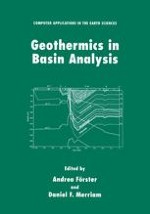1999 | OriginalPaper | Buchkapitel
Regional-Scale Geothermal and Hydrodynamic Regimes in the Alberta Basin: A Synthesis
verfasst von : Stefan Bachu
Erschienen in: Geothermics in Basin Analysis
Verlag: Springer US
Enthalten in: Professional Book Archive
Aktivieren Sie unsere intelligente Suche, um passende Fachinhalte oder Patente zu finden.
Wählen Sie Textabschnitte aus um mit Künstlicher Intelligenz passenden Patente zu finden. powered by
Markieren Sie Textabschnitte, um KI-gestützt weitere passende Inhalte zu finden. powered by
The flow of water and heat in a sedimentary basin may be coupled through buoyancy effects, caused by temperature variations, and through heat advection by flowing formation waters. However, there are situations when the two processes can be partially or totally decoupled. Such situations are when variations in formation water salinity offset variations in water density caused by temperature differences, and when rock permeability is so low that the velocity of fluid flow does not affect significantly the conduction of terrestrial heat through the sedimentary succession. The role of heat advection versus heat conduction in a sedimentary basin can be established through either numerical or dimensional analysis, based on the geothermal and hydrodynamic characteristics of the basin or parts thereof.The Alberta Basin in western Canada is complex in terms of hydrostratigraphy and flow of formation waters. Several basin-scale aquitards and aquicludes separate various aquifers and aquifer systems. On a regional scale, the flow of formation waters in aquifers is driven in various systems and directions by past tectonic compression, erosional rebound in thick shales, and regional- and local-scale topography. The salinity increase with depth offsets the decrease in density resulting from temperature increase. Formation-scale rock permeability in aquifers is low, leading to formation water velocities of the order of 10−2 m/yr. Dimensional analysis shows that conduction dominates the terrestrial heat flow in the basin, except for the Middle Devonian Elk Point aquifer system at the northern edge of the basin.The thermal conductivity of the sedimentary succession increases generally eastward, from 1.4 to 2.2 W/m °K. The basement heat flow, calculated on the basis of rock lithology, surface and bottom-hole temperatures, and thermal conductivity measurements, increases generally northward, from 40 to 80 mW/m2. This corresponds on a basin scale to changes in basement structure from old Archean rocks in the south to younger magmatic arcs in the north. Accordingly, geothermal gradients range from less than 20 mK/m in the south to more than 45 mK/m in the north. Local-scale anomalies are superimposed on this general trend. These anomalies are the result of basement heterogeneity, variations in radiogenic heat production by basement rocks, and stratigraphic and lithologic variability caused mainly by erosion. Only at the northern edge of the basin, high permeability of the Elk Point aquifer system, caused by reefs, dolomitization, fracturing and karst processes, leads to focused flow along the reef barrier and to heat advection by formation waters stronger than heat conduction. The advection of heat by formation waters discharging from this aquifer at outcrop near Great Slave Lake explains the high geothermal gradients (> 70 mK/m) observed at shallow depths near the Precambrian Shield at the northeastern corner of the basin featheredge.
